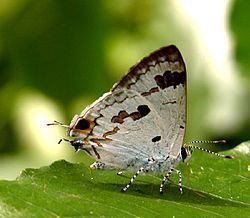Rank Species | Scientific name Chliaria othona Higher classification Chliaria Order Butterflies and moths | |
 | ||
Similar Hypolycaena, Catapaecilma, Chliaria kina, Hypolycaena erylus, Horaga | ||
Chliaria othona, the orchid tit, is a species of lycaenid or blue butterfly found in Asia.
Contents
The orchid tit is one of the rare butterflies belonging to the family Lycaenidae (Kehimkar, 2008). This butterfly is fairly common in northern India, but was reported to be very rare in southern India. In India, Chliaria othona is distributed in the Western Ghats, Uttaranchal to Arunachal Pradesh, the northeast, West Bengal and the Andaman Islands. It was also reported from Nepal, Bhutan, Bangladesh and Myanmar. The species prefers wet forests of up to 1524 meters altitude from the mean sea level and occasionally visits damp patches for mud-puddling. The caterpillars of orchid tit feed on the flower buds and flowers of orchids, hence the name.
Description
The orchid tit is a small butterfly which has a wingspan of 24 to 27 mm. The butterfly has two tails, one is 4 mm long at V1 and the other 2 mm long at V2.
Upperside:Underside: Both sexes are white below with black-edged brown markings and bars at end cell. The forewing has a discal band which is broken around V4 and which is broader above the break. There is a prominent black costal spot above the mid-cell. The hindwing also has a discal band broken in 4 and 6 with a prominent black spot towards the base of 7. The butterfly also has prominent orange-crowned tornal spots.Distribution
The orchid tit is found in Bangladesh, India, Myanmar, Thailand, Laos, northern Vietnam, Peninsular Malaysia, Pulau Tioman and possibly Taiwan.
In India the butterfly is found in the Western Ghats, the Himalayas from Garhwal to Assam, Bengal and onto Myanmar.
In Sikkim, the orchid tit is found up to an altitude of 5,000 feet (1,500 m).
Status
The species is considered rare in southern India, but not rare in the north.
Habits
The orchid tit is to be found in dense, rainy jungles. It is rarely seen except around its food plants - the flower buds of epiphytic orchids. It flies weakly and settles on flowers, leaves. It visits damp patches.
Life cycle
Caterpillar - Green onisciform (woodlouse-shaped) larvae with red dorsal band and three red rippled lines on each side. The caterpillar's head is concealed and its body is covered with minute bristles. Distinct short protuberances extend from the anal segment. It feeds on the flowers of the orchid.
Pupa - Smooth and greenish grey, resembles those of other Lycaenidae species. It has a few white markings, with a distinctly wavy pattern on the wing covers. It is found fastened along the stem of the orchids.
Larval food plants - The orchid tit's larval host plants are from the family Orchidaceae from genera Arundina, Dendrobium, Papilionanthe, Phaius, Phalaenopsis, Spathoglottis and the specific species are Papilionanthe subulata and Spathoglottis plicata
